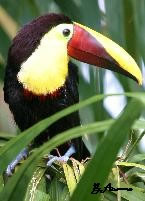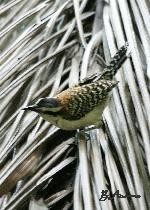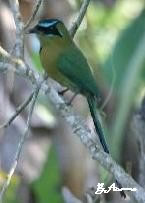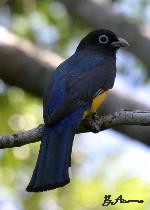Visit your favourite destinations |
| A Report from birdtours.co.uk |
Costa Rica - June 2005,
For a photo filled version of this report please visit the authors web site
After years of wishful thinking, we finally made it to Costa Rica in June 2005. We left Redding, California in the early evening of June 14 and after flying all night arrived at San Jose airport at 7:30 a.m. on the 15th. We were quite pleased to make it through customs, rent our 4X4 and cell phone, and were driving toward Orotina by 9:00 a.m. We had heard about the black and white owls at the city park and wanted to have the chance to see them. We speak (and read) very little Spanish and after seeing the owls we preceded to drive the wrong way down a one way street. Probably was a good thing we learned that lesson early in the trip.
 |
 |
 |
 |
Chestnut-mandibled Toucan |
Rufous-naped Wren |
Blue-crowned Motmot |
Black-headed Trogon |
We finally made it to the Rio Tarcoles about 11:30 a.m. and stopped long enough
to take a quick look at the crocodiles in the river. We counted 42 of them.
Then we headed for Villa Lapas to drop off our luggage so that we could bird
and not worry about the car being broken into.
While we were still on the grounds of the resort, we saw a chestnut-mandibled
toucan, golden-hooded tanagers, a green kingfisher, rufous-naped wrens, rufous-tailed
hummingbirds,a yellow-throated euphonia, common tody flycatchers, and a Hoffman's
woodpecker. After walking across the creek on a hanging bridge, we saw a blue-crowned
motmot, sulfur-rumped flycatcher, white-whiskered puffbird, black-headed trogon
and various other birds.
We wanted to be back at the bridge in time to see the macaws fly over, so we
took a quick trip out to the mouth of the Tarcoles River. Along the way we
were pleased to see a yellow-headed caracara, some scarlet -rumped tanagers
(pacific race), a squirrel cuckoo, blue-black grassquits, a pair of variable
seedeaters, and a lineated woodpecker. At the river, there were mangrove swallows,
egrets, black-bellied whistling ducks, a couple of white ibis, brown pelicans
and a frigatebird. It was getting close to sundown, so we headed back to the
bridge in time for the flyby! You could hear them coming as we arrived and
parked by the little police shed.
The next morning, after a restless night as the iguanas on our roof chose to
be quite noisy, we birded the road up to the waterfall fall. It was a great
morning. Gray-headed tanagers, a pair of rose-breasted becards building a nest,
a white hawk, violaceous trogon, black-headed trogon, white-shouldered tanager,
green and red-legged honeycreepers, buff-breasted saltators, masked tityra,
and orange-chinned parakeets. At the gardens near the waterfall over look we
saw a golden-naped woodpecker, a long-tailed hermit, steely-vented hummingbird,
scaly-breasted hummingbird,a little hermit, and a fork-tailed emerald.
We found a nice restaraunt right on the beach called Steve and Lisa's. A
perfect place to eat and wait out the afternoon shower. June is part of the "rainy" season
in Costa Rica and every afternoon there was a nice downpour. A few of the days
we were there it also rained on into the night, but every morning, the weather
was either sunny or just overcast and stayed that way until about 3:00 p.m.
We weren't bothered by the weather except on our visit to Tapanti National
Park. We just planned our day arround it and had our ponchos handy to cover
our cameras and binoculars.
When the rain stopped we headed for Cerro Bed and Breakfast, a simple Tican
home on a hill overlooking the Gulf of Nicoya. The grounds were very pretty
and the home neat and clean. Federico Ferraro was a friendly and gracious host,
providing us with the best breakfast we had on our entire trip. Knowing that
we were meeting a guide at Carara at 5:30 a.m. he got up early and fixed our
breakfast. His home is about a 15 minute drive to the entrance of Carara. The
added bonus of staying there was the birding we did as we headed up the 3 km
dirt road to his home. The first evening, we stayed two, we saw 9 turquoise-browed
motmots on the way in. The second night we started a little earlier and saw,
motmots, rufous-tailed hummingbirds,a cinnamon hummingbird, a magpie jay (only
one we saw on the trip), ferruginous pygmy-owls, a squirrel cuckoo, rose-throated
becards, and a stripe-headed sparrow were the notable birds. The next morning,
there was a scarlet macaw flyby right over the property.
Carara was awesome and our list of birds long. I'll mention just a few of the
ones we were most excited about seeing. We didn't get good photo-ops because
it was overcast and the canopy so thick that the low light caused most of our
shots to turn out blurry. Just a note to anyone planning a birding trip. You
can't get into the park until 7:00 a.m. unless you have prescheduled a guide
to go with you. Note-worthy birds for us: purple-crowned fairy, long-tailed
hermit, little hermit, gray-necked woodrail, boat-billed heron, American pygmy
kingfisher, black-hooded antshrike, chestnut-backed antbird, barred antshrike,
rufous-breasted wren, rufous and white wren, royal flycatcher, slate-headed
tody flycatcher, dotted-winged antwren, bare-throated tiger heron, plain xenops,
orange-billed sparrow, spotted woodcreeper, tawny-winged woodcreeper, streak-headed
woodcreeper, white-winged becard, slaty-tailed trogon, orange-chinned parakeets
and a striped cuckoo. We heard a collared forest-falcon and a rufous-tailed
jacamar. Here's the joke on us. While with the guide, we followed the calls
of scarlet macaws from the canopy, off the main trail, craning our necks and
getting eaten by mosquitos, sure at any moment we were going to encounter some
poisonous snake, but never did get a look at one (macaw that is). About 3 in
the afternoon, we decided to go back for one last try at a close-up of a macaw.
We returned to the spots the guide had led us to earlier and finally got a
couple of long shots through the trees. It started to sprinkle so we headed
for the parking area. About 100 yards from the exit there were 3 macaws sitting
in plain sight of the main trail. We got our pictures!
Now, we were off to San Gerardo de Dota in hopes of seeing a quetzal. We headed
down to Quepos thinking we might stop at the beach along the way. Instead we
stopped several times along the way to look at hawks. Most of the times we
didn't get stopped soon enough to make identifications, but we did add a roadside
hawk, gray hawk, crested caracara and a swallow-tailed kite to our list. Then
came the road from Quepos to Dominical. Thank goodness for the 4X4. Let's just
say, it's very rutted and the trucks in Costa Rica never pull over to let you
by. In fact, they weave from side to side dodging the holes without ever looking
in the rear-view mirror. We arrived in San Isidro de General in time for lunch
after adding an Amazon kingfisher and a blue dacnis to our list. Now our dilema
was what to do for lunch with all our belongings in the car. It is not safe
to leave things in your car in Costa Rica especially in a big city (No different
than L.A). The solution was McDonald's take-out. We ate in the parking lot.
San Isidro was the only big city we were in during our stay in Costa Rica.
We made a big circle around San Jose as the airport is actually in the town
of Alajuela. McDonald's was the only fast food restaraunt we saw on this trip.
After lunch, we began what was to be my worst 2 hours of the vacation. We headed
out of San Isidro on the Interamerican Highway, the main highway connecting
all of Central America. Within 10 minutes we hit fog, fog so thick that my
camera couldn't focus enough to take a picture. The road was very steep, windy
and narrow. Since this is the main road connecting two of the biggest cities
of Costa Rica, it is used by many trucks. The trucks couldn't travel faster
than 20 kph, so everyone just pulled out and passed, even if you could only
see about 100 meters or less ahead of you on a windy road. I have never been
so happy to exit a road in my life. Bill was happy too! No more listening to
my panic!!
While in the San Gerardo de Dota area we stayed at both the Trogon Lodge and
the Savegre Lodge. While the Trogon Lodge receives a lot less acclaim than
the Savegre, we were very pleasantly surprised at how beautiful the rooms and
grounds were. We would have been happy to stay there the entire 3 days we were
in the area. The first morning we were there, Alex, an employee of Trogon Lodge,
showed us a quetzal nest near the parking area for a waterfall just past the
entrance to the Savegre Lodge. The male was on the nest when we arrived. About
half an hour later the female arrived with a grasshopper to feed the young.
She called from a tree nearby. The male exited and sat in the tree for a while
until an emerald toucanet got too close to the nest and the male quetzal began
to attack it, trying to drive it off. After about 3 attacks, the toucanet headed
off. It was awesome.
Besides the quetzals and toucanet, we saw 61 other species of birds in the
San Gerardo de Dota area. Some of our favorites were the gray-tailed (white-throated)
mountain gem whose female is as beautiful as any male, volcano hummingbird,
scintillant hummingbird, green violet-ear, violet sabrewing, collared trogon
female, spotted wood-quail, sulpher-winged parakeet, buffy tuftedcheek, tufted
flycatcher, torrent tyrannulet, spot-crowned woodcreeper, long-tailed silky
flycatcher, black-faced solitaire, flame-throated warbler, collared redstart,
black-cheeked warbler, flame-colored tanager, silver-throated tanager, spangle-cheeked
tanager, slaty flowerpiercer, black-thighed grosbeak, yellow-bellied siskin,
and the elegant euphonia (blue-hooded).
We left Savegre Lodge in the rain and headed for Tapanti National Park. This
was the only day that the rain really impacted us. We had planned to spend
an hour birding before heading out, but reminded each other that this would
give us extra time at Tapanti, where we had only planned on a 24 hr period
of time. What we didn't know was that it would only stop raining for a short
period of time that day. Of course, that would be the time while we were driving.
We left our things at Kiri Lodge during a break in the weather and hurried
to the park. We were about 15 minutes down the first trail when the heavens
opened up. Thankfully there was a covered picnic area about 100 meters away.
As we ducked underneath, we startled a slaty-backed nightingale-thrush that
hopped away just out of sight, but continued to sing to us from somewhere close
by. But this downpour was even more than we wanted to brave with our ponchos.
We waited for an hour then headed back to the SUV during a slowdown. About
40 minutes before sunset, it stopped long enough for us to take a short walk
down the road. The birds were happy to be out of the rain and several varieties
showed up. Activity included a red-headed barbet, several silver-throated tanagers,
golden-browed chlorophonia, tufted flycatcher, chestnut-headed oropendola,
scarlet-thighed dacnis, olivaceous woodcreeper, red-faced spinetail, slate-throated
redstart, palm tanager, a male collared trogon, and a black-faced grosbeak.
Early the next morning on the road to the park (it also didn't open until 7)
we added a red-eyed vireo, green thorntail, tawny-capped euphonia, spotted
antpitta, mistletoe tyrannulet, dusky-faced tanager, passerini tanager, white-eared
ground sparrow, and a yellow-throated brush-finch, there were other misc. ones
we didn't bother to write down as we had seen them before..
Our day at Rancho Naturalista was jam-packed. Since we were the only guests
there, I think we got extra special attention. We arrived at noon and were
met by Leo, a young man who turned out to be the best guide of our entire trip.
(We had 3 others) He knew every bird sound and if he heard it he could almost
always find it, just where to look for specialty birds and great ways of calling
them in. He also carried a pointer that he used when we were having trouble
spotting some far off bird. We had to leave for La Selva by noon the following
day, but in that short period of time we saw 104 species and Leo saw a few
more that we missed. Our favorites: sunbittern, brown-headed parrot, white-crowned
parrot, green hermit, white-necked jacobin, brown violet-ear, violet-headed
hummingbird, blue-throated goldentail, snowcap, rufous motmot, blue-crowned
motmot, rufous-winged woodpecker, golden-olive woodpecker, brown-billed scythebill,
russet antshrike, checker-throated antwren, dusky antbird, immaculate antbird,
white-collared manakin, white-crowned manakin, white-ruffed manakin, scale-crested
pygmy tyrant, rufous mourner, piratic flycatcher, cinnamon becard, black-throated
wren, stripe-breasted wren, black-headed nightingale-thrush, yellow-green vireo,
tropical parula, golden-crowned warbler, black and yellow tanager, white-lined
tanager, bay-headed tanager, speckled tanager, yellow-faced grassquit, black-striped
sparrow, and Montezuma oropendola.
The staff at Rancho Naturalista stuffed us one final time, and we were off
to La Selva. The food at Naturalista was top of the line! Best guide, good
food, terrific accomodations and without a doubt our visit to Rancho Naturalist
was a highlight of our trip to Costa Rica. The pictures below are of our room
and of Bill and Leo (guide) on the open patio where we enjoyed all of our meals
and watched hummingbirds at the same time.There was a lovely diningroom too,
but we enjoyed being outside.
Just as we arrived at Gavilan Rio Sarapiqui Lodge a collared aricari flew past
our SUV and landed above the room we would be staying in. WOW! The manager
had arranged a guide for us at La Selva for the morning of the 24th and a boat
trip on the Rio Sarapiqui for the morning of the 25th.
We had really been looking forward to our trip to La Selva. It has the largest
list, by far, of species found in the area. We arrived at the gate at 5:45
a.m. and after paying for entrance fees and for the guide ($72 for the 2 of
us) we headed out with the guide at about 6:10. About an hour and a half later,
with only 29 species on our list (8 life birds), the guide informed us it was
time to head back as he had another group to lead at 8:00. As he was dropping
us back at headquarters at 7:50, Bill and I looked at each other and shook
our heads and Bill made the comment that he wished we could have brought Leo
with us. Since no one kicked us out, we retraced the path we had followed with
the guide and in fact made it out to the end of the main pathway. Life birds
seen with the guide, red-lored parrot, mealy parrot, bay wren, buff-rumped
warbler, gray-rumped swift, black-crowned tityra, scarlet-rumped cacique, laughing
falcon (h) and plain-colored tanager. Life birds seen by ourselves, white-necked
puffbird, chestnut-collared woodpecker, rufous-tailed jacamar, white-breasted
wren, olive-backed euphonia, great antshrike, king vulture, yellow tyrannulet,
band-backed wren, smoky-brown woodpecker,striated-green heron, thrushlike manakin,
yellow-billed cacique and crimson-collared tanager. Other good birds seen without
the guide, golden-hooded tanager, masked tityra, black-cowled oriole, barred
woodcreeper, little hermit, blue dacnis, scarlet-thighed dacnis, bronzy hermit,
long-tailed hermit, red-footed plumeleteer, rufous motmot, and a white-collared
manakin that played the "click" game with us for about 10 minutes. Bill would
entice it to one spot by snapping his fingers, then we'd head about 20 feet
down the pathway and Bill would snap a few times again and it would follow
us there. We gave up the game when the jacamar we had been straining to see
through the undergrowth earlier landed on the pathway in front of us and proceeded
to take a dust bath. Oh, as we were peering in the tangle of vines, looking
for the manakin, I suddenly realized that about 15 feet away there was a boa
stretched out and resting away from the heat. A big one too!!!
After leaving the main gate, we walked down the road a ways. Actually we were
following a slaty-tailed trogon, looking for photo ops. Just past a decorative
entry that was under construction, we both saw what appeared to be a green
macaw fly from treetop to treetop in the distance, but it was too far away
for a positive ID. As we headed back to the SUV, there near the gate were 6
peccaries. So it wasn't such a bad morning after all.
That afternoon there was a thunderstorm that lasted into the night. In a simple
Tican dwelling, the noise is quite deafening. But the relief from the heat
was welcome.
Our boat met us at the Gavilan dock in the morning and the driver, guide, assured
us that since we were the only clients on board (green-season) we could just
yell stop at any time and he would move the boat in for a closer look. Most
of the time he stopped for things before we asked and made a real effort for
us to get pictures along the way. He even pulled the boat up under a tree beneath
a sleeping sloth and proceeded to shake the tree and bang on the boat until
it "moved" for us.
On June 25, we moved to the La Quinta Country Inn. It has beautiful grounds
and nice rooms, each with its own patio with chairs and hammock. And we had
our own Bronzy Hermit that spent long periods sitting on the flowering vines
that surrounded our patio. A short walk around the grounds yielded some great
birds. Olive-backed euphonia, red-legged honeycreeper, keel-billed toucan,
gray-necked woodrails, golden-hooded tanagers, green kingfisher, Montezuma
oropendolas, black-cowled orioles, passerini tanagers, and of course, blue-gray
tanagers which are very pretty, but common in Costa Rica.
June 26 was a busy one. We headed out just at dawn for Virgen del Socorro.
As we tiptoed past the other rooms, we saw the funniest thing. A red-legged
honeycreeper looking at itself in the glass on the pool room windows. It was
so engrossed that we had time to get our cameras out of their cases and take
about 6 pictures each before it came to its senses and flew away.
After a great morning walking the dirt road down to the bridge, we headed for
La Paz Catarata. Virgen birds: blue dacnis, scarlet-thighed dacnis, shinning
honeycreeper, emerald toucanet, red-headed barbet, silver-throated tanager,
spangled-cheeked tanager, slate-throated redstart, sooty-faced finch, wedge-billed
woodcreeper, yellow and black tanager, green honeycreeper, bay-headed tanager,
sooty-capped brush-tanager, dotted-winged antwren, tropical parula, American
dipper, slaty-backed nightingale-thrush, black phoebe, white-ruffed manakin,
bright-rumped attila, black-breasted wood-quail, crimson-collared tanager,
torrent tyrannulet, and a collared trogon.
La Paz Waterfall Gardens are an unforgettable experience. The entire garden
is beautiful. Each of the waterfalls are spectacular,but we only had our long
lenses along and couldn't get pictures of the waterfalls because we were too
close. (catching the spray close) As we were heading back to La Quinta, we
found a place where we could pull off and take a picture of the La Paz Waterfall
from the road, but even then we were too close to get the entire waterfall
in the picture, and the pool at the bottom is half the beauty.
In the covered Butterfly Garden, not only are the butterflies beautiful, but
there was a kiosk with hundreds of chrysalis' from each of the varieties, some
hatching as we watched.
At the Hummingbird Garden there were hundreds of hummingbirds zooming around.
The garden provided individual feeders that you could hold and the hummers
would come right in. We took pictures and held feeders for about half an hour.
We had planned to come back after walking the trails and just sit and look
for the rare birds, but the afternoon showers began around 3:30 and we left.
On the way down the hill we stopped for lunch/supper at a little "soda", a
little restaraunt called Mirador de Catarata which means "overlooking the waterfall".
We had heard this was a great place to view hummingbirds and we were not disappointed.
The back patio overlooks the San Fernando Waterfall, and has 7 or 8 feeders
that are constantly full. We added a striped-tailed hummingbird to our list
and we got a great male thorntail picture while we were there. It was a pleasant
experience.
There were just 3 days left of our vacation and while birding was the main
purpose of this trip, we now set off to enjoy the Arenal Volcano. We had heard
that the top of the mountain is frequently obscured by a cloud cover so we
were pleased to see the mountain as we pulled into La Fortuna.
That evening we drove around to the west side of the mountain to watch the
molten rocks that regularly spill over the top and down the side. You could
hear the rumble of the moving rocks and follow their path downward. We returned
to the lodge and ended up sitting on the porch listening to the mountain. (The
lava activity was not visable from this side.) Suddenly, there was a really
loud rumble and fire and molten rocks began shooting out the top. It continued
for about 8-10 seconds. It was really awesome!!
The next day we hiked down to the La Fortuna Waterfall. It was very beautiful.
We just sat and watched it for awhile. Then several groups of people came and
began swimming in the pools near the bottom, so we left.
June 29 and our final day in Costa Rica. We went in the morning to the Hanging
Bridges, a 3 km walk in the rain forest complete with 6 hanging bridges and
8 fixed bridges that get you up into the canopy. It was while we were in this
forest area that Arenal had its biggest eruption while we were in the area.
There was a huge roaring and rumbling, about 3 times as loud as anything we
had heard before. It lasted for about 20 seconds. How I would have liked to
have seen what was going on!!!! But we did get to see poison dart frogs, an
eyelash pit-viper, howler monkeys and a rufous motmot. We also heard the distinct
calling of a Bellbird. And then the vacation was over. We headed back to Alajuela
telling each other how much we would like to do it again sometime!
During the trip we saw 314 species of birds. 240 of them were life birds for
us. If you would like to ask us any questions or make any comments please contact
us at adamfam@charter.net
Cameras used were a Canon 10D with a Canon 100-400 IS lens
and a Pentax istD with a Tamron 100-300 lens.
All pictures have been compressed and have lost some of their resolution
and their abiltiy to be enlarged.
Why not send us a report, or an update to one of your current reports?